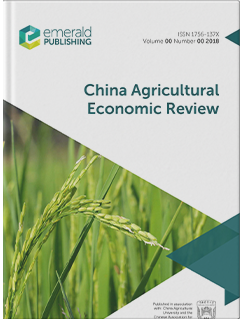The effect of export tax rebates on product quality: evidence from China's agricultural product processing industry
IF 4.6
2区 经济学
Q1 AGRICULTURAL ECONOMICS & POLICY
引用次数: 1
Abstract
PurposeThis study aims to establish the linkage among export tax rebate (ETR), firm innovation and product quality of Chinese agricultural product processing industry (APPI), so that more targeted policy implications can be discussed.Design/methodology/approachUsing highly disaggregated firm-product-destination-level data through 2001 to 2013 of Chinese APPI, this study employs a two-way fixed effects specification to establish the linkage between ETR and product quality, while the mediational model is adopted to examine potential mechanisms.FindingsBaseline estimates show that a 1% increase in ETR rate leads to a significant increase in the product quality of APPI by 0.12% on the whole. However, there is a nonlinear, inverse-U shaped relationship between ETR and product quality, and the optimal inflection point occurs when ERT rate equals 0.15. Mechanism analyses show that firm innovation is an important impact channel, which explains 9.8% of quality improvement induced by raising ETR. Further heterogeneous analyses reveal both the total effects of ETR on product quality and the mediation effects of innovation are dominated by young SMEs (small and medium-size enterprises).Practical implicationsAuthorities can promote the innovation and then product quality improvement of young SMEs by moderately increasing ETR rate. To ensure ETR more effective in improving quality, it is necessary for the government to encourage innovation. Authorities can reduce the risk of innovation failure for low-tech firms by increasing R&D subsidies, while ensuring innovation returns for high-tech firms in combination with stronger intellectual property protection.Originality/valueFirst, this is one of the earlier studies to explore the relationship between ETR and product quality specifically for Chinese APPI. Second, we show firm innovation as an important mediator so that policies aim at raising ETR rates are eventually beneficial to product quality. Third, using the highly disaggregated data, we allow ETR rate to vary across different products, which is an improvement in the accuracy of previous literature. Finally, our research provides additional empirical evidence for revealing the micro-mechanism of ETR affecting firm behaviors.出口退税对产品质量的影响:来自中国农产品加工业的证据
目的建立我国农产品加工业出口退税、企业创新与产品质量之间的联系,为更具针对性的政策启示提供依据。本研究利用2001 - 2013年中国企业-产品-目的地高度分类的数据,采用双向固定效应规范建立ETR与产品质量之间的联系,并采用中介模型检验潜在机制。研究结果基线估计表明,ETR率每提高1%,APPI产品质量总体上显著提高0.12%。但ETR与产品质量之间存在非线性的倒u型关系,最佳拐点出现在ERT率= 0.15时。机制分析表明,企业创新是重要的影响渠道,它解释了9.8%的提高ETR导致的质量改善。进一步的异质性分析表明,ETR对产品质量的总效应和创新的中介效应都由年轻的中小企业主导。实践意义当局可以通过适度提高ETR率来促进年轻中小企业的创新,进而促进产品质量的提高。为了确保ETR更有效地提高质量,政府有必要鼓励创新。当局可以通过增加研发补贴来降低低技术企业创新失败的风险,同时通过加强知识产权保护来确保高技术企业的创新回报。首先,这是较早的专门针对中国APPI探索ETR与产品质量关系的研究之一。其次,我们发现企业创新是一个重要的中介,因此旨在提高ETR率的政策最终有利于产品质量。第三,使用高度分解的数据,我们允许不同产品的ETR率变化,这是先前文献准确性的改进。最后,我们的研究为揭示ETR影响企业行为的微观机制提供了额外的经验证据。
本文章由计算机程序翻译,如有差异,请以英文原文为准。
求助全文
约1分钟内获得全文
求助全文
来源期刊

China Agricultural Economic Review
AGRICULTURAL ECONOMICS & POLICY-
CiteScore
9.80
自引率
5.90%
发文量
41
审稿时长
>12 weeks
期刊介绍:
Published in association with China Agricultural University and the Chinese Association for Agricultural Economics, China Agricultural Economic Review publishes academic writings by international scholars, and particularly encourages empirical work that can be replicated and extended by others; and research articles that employ econometric and statistical hypothesis testing, optimization and simulation models. The journal aims to publish research which can be applied to China’s agricultural and rural policy-making process, the development of the agricultural economics discipline and to developing countries hoping to learn from China’s agricultural and rural development.
 求助内容:
求助内容: 应助结果提醒方式:
应助结果提醒方式:


